LOUDSPEAKERS
You also want an ePaper? Increase the reach of your titles
YUMPU automatically turns print PDFs into web optimized ePapers that Google loves.
go to: Contents | Features | Bookshelf, Stand-Mount and Desktop | Floorstanding | Editors' Choice Awards<br />
EQUIPMENT REVIEW - KEF Blade<br />
know what I mean.) Indeed, other state-of-theart<br />
speakers from Wilson, Magico, YG, mbl, etc.,<br />
tend to be dearer than the Blades. And yet I would<br />
unhesitatingly put the Blades in their league. I won’t<br />
call them a bargain—that would be the Maggie<br />
3.7s—but I will say they deliver high value within<br />
their class.<br />
A speaker decision in this price range is bound<br />
to take into account many factors. In the case of<br />
the Blades, aesthetics are apt to be one of them.<br />
Their visual design was driven by their ambitious<br />
sonic goals (see “Behind the Blade’s Unique<br />
Façade”) and by KEF’s desire to make a modern<br />
industrial design statement. The result is one of<br />
industry’s most unusual shapes. In my home the<br />
big speaker evoked a variety of reactions. Some<br />
observers found the Blades “weird” looking, while<br />
others were intrigued. My kids immediately dubbed<br />
them the “fisheyes.” Perhaps tellingly, the most<br />
enthusiastic response came from a professional<br />
interior designer friend of mine, who dubbed them<br />
“awesome.” The fact that they can be customordered<br />
in sixteen colors sent her right over the<br />
edge. Personally, I have grown to appreciate the<br />
Blade’s form. Having lived with them for several<br />
months, I find that traditional box speakers now<br />
strike my eye as dull and dated.<br />
Apparently I am not alone. KEF reports<br />
significant early interest in the product based solely<br />
on its looks. Perhaps the well-heeled Significant<br />
Others of the world, who generally abhor big<br />
box speakers, will take a shine to the Blades and<br />
advocate their purchase. If that happens to you,<br />
knowing what you now know about their sound, for<br />
heaven’s sake consent.<br />
KEF’s Blade is a statement speaker in so many<br />
ways: as an aesthetic object; as a culmination of<br />
knowledge and experience gained over fifty years;<br />
as a demonstration that advanced technology can<br />
solve certain problems that brute force and exotic<br />
materials cannot; as the fulfillment of a theoretical<br />
ideal—and proof that the predicted benefits are<br />
real; and as the fruition of five years of work that<br />
not only met but exceeded all of its design goals.<br />
Above all, the Blade is a speaker that delivers an<br />
inordinate quantity of sonic and musical delight—<br />
no matter what you’re listening to.<br />
Behind the Blade’s Unique Façade<br />
The heart of the Blade’s design is the company’s familiar Uni-Q driver, in which the tweeter is located<br />
at the center of the midrange cone. Unlike old-fashioned coaxial drivers, this coincident driver<br />
arrangement avoids interference between each driver’s sonic spheres. Placing the tweeter right at the<br />
apex of the midrange cone unifies the two dispersion patterns. Another advantage of the Uni-Q is that<br />
its two component drivers are inherently time-aligned.<br />
Although the concept of concentric drivers—and, indeed, the Uni-Q itself—is decades old, KEF has<br />
continually refined it to more closely match the two drivers’ dispersion patterns. As always, the<br />
midrange cone acts as a “waveguide” for the tweeter’s lower frequencies, but in the Blade that cone is<br />
made from aluminum backed by a liquid crystal polymer skeleton. The extra rigidity conferred by those<br />
skeletal ribs not only makes for a better midrange driver, it improves tweeter performance. Meanwhile,<br />
a redesigned tweeter-dome shape, capped by the new “tangerine” waveguide, tames tweeter<br />
dispersion at the uppermost frequencies, while also providing poke protection.<br />
But how does bass get integrated into this carefully constructed mid/high point-source pattern<br />
The answer lies in the Blade’s use of four 9" woofers, two on each side of the cabinet. KEF chose side<br />
drivers for a multitude of reasons. First, physically connecting opposing woofers back-to-back cancels<br />
the cabinet vibrations a single woofer would induce. Second, the arrangement allows for a narrow front<br />
baffle, which minimizes diffraction. Third, having two stacked woofers per side widens dispersion at<br />
the top of their range, allowing the bass dispersion pattern to better blend with that of the midrange.<br />
Fourth, the woofer placement moves their center point well away from floor, avoiding that early<br />
reflection.<br />
Most importantly, though, the configuration allows the four bass drivers to be as close as possible<br />
to each other—and to the Uni-Q. This proximity to and symmetry around the Uni-Q is the key to the<br />
Blade’s full-range point-source capability. The arrangement positions the woofer cluster’s acoustic<br />
center such that it aligns precisely with that of the Uni-Q. The front baffle’s curved surface then serves<br />
as a final waveguide for the entire ensemble.<br />
Of course, the front baffle is not the only curved surface on the Blade. The entire cabinet (minus<br />
the base plate) consists of just two large curved pieces; one comprises the sides and front, the other<br />
forms the top and rear. KEF wanted a bold shape for its flagship for aesthetic reasons, but the curved<br />
cabinet also enhances rigidity, thereby reducing vibrations. Rigidity is further increased by extensive,<br />
computer-optimized internal bracing. Finally, the enclosure is made of glass-reinforced composite fiber,<br />
which is similar in strength to carbon fiber, though not as light (as I can personally attest). AT<br />
101 Guide to High-Performance Loudspeakers www.theabsolutesound.com<br />
previous page<br />
NEXT page

















